|
MARIANI’S
Virtual Gourmet
June
25, 2006
NEWSLETTER
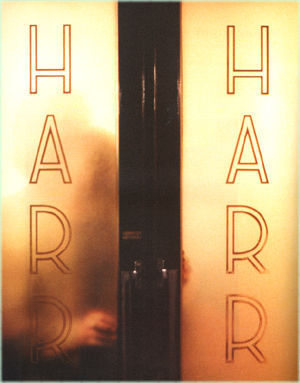
The Door to Harry's Bar, Venice, Italy
"Then he was pulling open the door of Harry's bar and was inside and he had
made it again, and was at
home."--Ernest Hemingway, Across the
River and Through the Trees (1950).
UPDATE: To
go to my web site, in which I will update food
&
travel information and help link readers to other first-rate travel
& food sites, click on: home page
ACCESS TO
ARCHIVE: Readers may now access
an
Archive of all past newsletters--each annotated--dating back to July,
2003, by simply clicking on www.johnmariani.com/archive
.
NEW
FEATURE! You may now subscribe anyone you wish
to this newsletter by
clicking here.
In
This Issue
Truth in Trout by
John
Mariani
NEW YORK CORNER: Ennio
& Michael by John Mariani
NOTES
FROM THE WINE CELLAR: The 10 Myths of Wine
QUICK
BYTES
TROUT
by
John Mariani
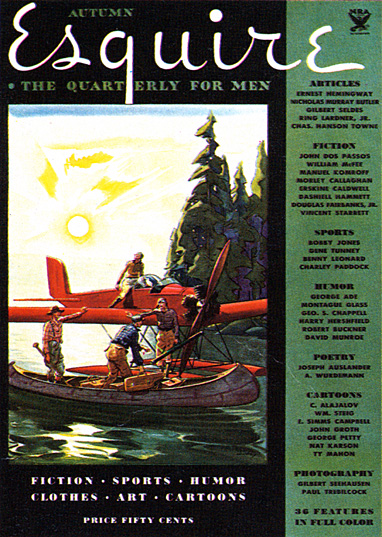 Esquire Magazine's first cover,
Autumn 1933 Esquire Magazine's first cover,
Autumn 1933
If
I had to name the tastiest fish in the sea, I would have a hard
time
deciding
among turbot, Dover sole, John
Dory, and half a dozen other species. But when it
comes to freshwater fish, there is nothing that leaps to mind like the
trout.
The blueback, the red trout, the ruby, the golden, the brown, the
cutthroat,
the speckled trout, the multi-spotted Dolly Varden, the rainbow, the
steelhead--each beautiful in its way, with flesh that tastes of and is
colored
by what it eats.
A
trout is amenable to a fair array of cooking treatments, though not to
all. It
is superb with buttered almonds, succulent to the bone when stuffed
with
crabmeat or a mousseline, made tangy with fresh capers, and as good as
fried
fish can possibly be, especially in bacon fat. And
even though we must suspend our belief, in light of
game
regulations, that the best trout is the one we catch, the flavor
and spirit of the wild trout is a magical thing.
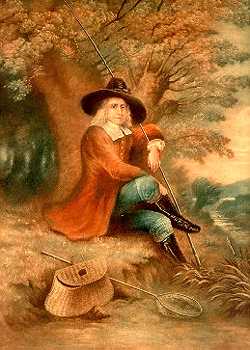 As anyone who has ever read Isaak
Walton's The Compleat Angler (1653) or
Norman MacLean's A River Runs Through It (1989) knows, of all the
fish
gathered by mankind, the trout has always evoked the most
romantic
associations. Let Jonah and Ahab have
their terrifying whales and the Old Man his
magnificent marlin. Trout fishing is part patience, part
endurance, part
boredom, part Zen
and part art. As MacLean put it in the
beautiful opening line of his
short story, "In our family there was no clear line between religion and fly
fishing."
(To order The Compleat Angler click on photo of
Isaak Walton at right.)
As anyone who has ever read Isaak
Walton's The Compleat Angler (1653) or
Norman MacLean's A River Runs Through It (1989) knows, of all the
fish
gathered by mankind, the trout has always evoked the most
romantic
associations. Let Jonah and Ahab have
their terrifying whales and the Old Man his
magnificent marlin. Trout fishing is part patience, part
endurance, part
boredom, part Zen
and part art. As MacLean put it in the
beautiful opening line of his
short story, "In our family there was no clear line between religion and fly
fishing."
(To order The Compleat Angler click on photo of
Isaak Walton at right.)
Most of all, trout fishing requires a
man to retreat into
the wild, to
find a silent stream with no one else around and to
spend some time in
contemplation. Even when other anglers
are included on a trout fishing expedition,
there is none of that yahoo
camaraderie and machismo that seems essential to bass fishing
over
the side of a motor boat. No, trout
fishing is a solitary act designed to bring pleasure to the angler and
unfortunate
pain to the fish. As Walton (above)
put
it, "when the lawyer is swallowed up with business and the
statesman
is preventing or contriving
plots, then we sit on cowslip-banks, hear the birds sing, and possess
ourselves
in as much quietness as these
silent silver streams which we now see glide so quietly by us."
 The trout, whose species span two
whole
genera, Salvelinus
and Salmo, is
spread throughout the world's rivers,
yet it seems the most American of
fish. Or at least the most American of American fish. In the
colonial
era it was everyday food for first
settlers, and by the nineteenth century there still seemed little
reason
to imitate the efforts of the
French, who constructed the first public-owned trout hatchery in 1852
to propagate
fish commercially. (France now has 700
trout-producing farms producing over 20,000 tons of
fish each
year.) Nevertheless, in 1864 Seth
Green set
up a hatchery in Mumford, New York. The trout, whose species span two
whole
genera, Salvelinus
and Salmo, is
spread throughout the world's rivers,
yet it seems the most American of
fish. Or at least the most American of American fish. In the
colonial
era it was everyday food for first
settlers, and by the nineteenth century there still seemed little
reason
to imitate the efforts of the
French, who constructed the first public-owned trout hatchery in 1852
to propagate
fish commercially. (France now has 700
trout-producing farms producing over 20,000 tons of
fish each
year.) Nevertheless, in 1864 Seth
Green set
up a hatchery in Mumford, New York.
Brad
Pitt in "A River Runs Through It" (1992)
American
anglers merely had to dip their
lines in the
rivers to come up
with large, beautiful fish perfect for
pan-frying on the spot. The only
dilemma was deciding which tackle to use to catch a particular trout in
a
particular place. Trout anglers gird for
battle and speak a language designed to keep most mortal men at
a
distance--floaters, sink tips, breaking
strain, hatches, and wonderfully fanciful names for flies like
Rat-Faced
McDougall, Humpy Adams, Living
Damsel, Greenwell's Glory, and Drowned Olive May.
Nevertheless America's first
great fishing author, Frank Forester, complained in his Fish and Fishing
(1849)
that Americans did not take their
fly-fishing with all due seriousness.
After the Civil War the days when anglers filled their baskets
with
forty trout in an afternoon were
fading fast. When the end came -- as a
result of industrial pollution and
invasion of the trout streams, as well
as overfishing -- it came quickly.
It
was the introduction of the German
brown trout (Salmo trutta) to North America in 1883, and
Green's stocking of his own hatcheries
with that fish in 1886, that
caused a comeback of the trout in America, while
native rainbow trout
(Salmo gairdneri) were being
introduced as far away as New Zealand and South Africa.
Protective
measures have also helped restore the trout populations,
and, since American anglers
have become
dutifully
serious about their sport,
efforts have been made to maintain the balance of nature in
trout
streams.
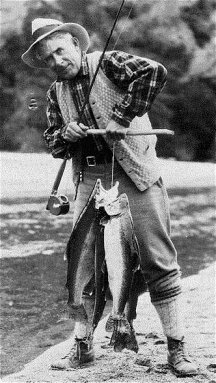 As
with anything that seems lost in an idyllic past, trout fishing took on
mythic
overtones, and there grew an
enormous amount of literature on the
subject of casting, lures and the most sensible way to approach
the
game. The finest literature on trout
has come from American authors, from specialists with wondrous
names
like George Michel Lucien La Branche,
Charles Zebulon Southard, Arthur Flick, Sparse Grey
Hackle,
and Ernest Schwiebert, to
outdoorsmen like Zane Grey ,
who wrote mostly fishing books, not westerns,
in his later life, John
Steinbeck, and Ernest Hemingway, whose long short story "Big
Two-Hearted River" is perhaps
the best thing ever written on the subject and
one of the classics of American
naturalism. (To order Hemingway
on Fishing, click on cover below; to order Zane Grey on
Fishing, click on the photo
of Grey at left)
Year by year the books on trout
keep coming--a
check of
Amazon.com turns
up more than 800 currently in print--and
magazines like Sports Afield,
Men's Journal and Field and
Stream keep the sport more vibrant than
it's ever been. Nowhere is this truer
than in the West, more specifically in the Rockies, where the
trout
run wild and plentifully. One can
easily find trout streams in the east, but the romantic, primordial
lure of
fishing the Rockies seems at the
heart of the matter. As
with anything that seems lost in an idyllic past, trout fishing took on
mythic
overtones, and there grew an
enormous amount of literature on the
subject of casting, lures and the most sensible way to approach
the
game. The finest literature on trout
has come from American authors, from specialists with wondrous
names
like George Michel Lucien La Branche,
Charles Zebulon Southard, Arthur Flick, Sparse Grey
Hackle,
and Ernest Schwiebert, to
outdoorsmen like Zane Grey ,
who wrote mostly fishing books, not westerns,
in his later life, John
Steinbeck, and Ernest Hemingway, whose long short story "Big
Two-Hearted River" is perhaps
the best thing ever written on the subject and
one of the classics of American
naturalism. (To order Hemingway
on Fishing, click on cover below; to order Zane Grey on
Fishing, click on the photo
of Grey at left)
Year by year the books on trout
keep coming--a
check of
Amazon.com turns
up more than 800 currently in print--and
magazines like Sports Afield,
Men's Journal and Field and
Stream keep the sport more vibrant than
it's ever been. Nowhere is this truer
than in the West, more specifically in the Rockies, where the
trout
run wild and plentifully. One can
easily find trout streams in the east, but the romantic, primordial
lure of
fishing the Rockies seems at the
heart of the matter.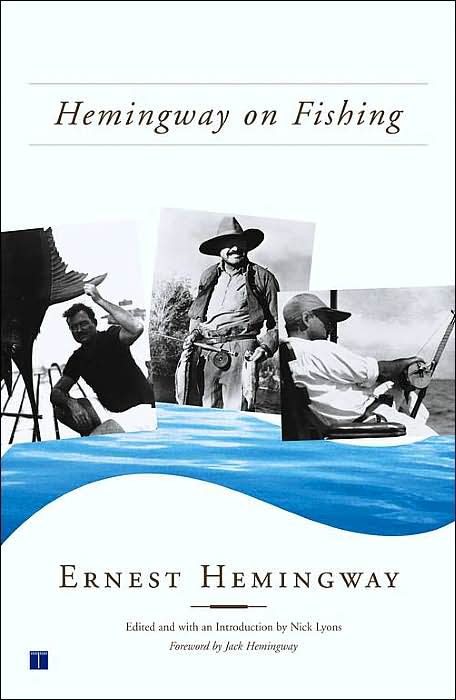
Fly
fishing is a good thing to learn early on, first, because
there's so much to learn;
second,
because children learn grace effortlessly; and three, because
life's
too short. You don't need much
gear--you can wear everything but the waders out to the hatch--and if
you
plan to eat what you catch on the spot,
you can pretty easily carry the pan, plates, knife and fork
you'll
need. And a coffee pot. As John
Gierach writes in a lovely essay about fishing the headwaters of the
western
United States, "The only
luxuries you've allowed yourself are a
full-sized coffeepot, a notebook, and
a modest-sized bottle of bourbon--but
maybe they're not entirely luxuries, at that. The
coffeepot doubles
as a saucepan, and holds enough
water to completely douse the campfire in three trips to the
stream.
Your life has been such that
there's the normal background noise of built,
but so far, you haven't burned down
a forest and don't plan to; you are meticulously careful with your fires."
Letting a trout go after catching it is
neither required
nor suggested,
unless you've been lucky enough to catch
more than you could possibly eat. I
still believe the difference between a good hunter and a bad one
is
that the former only eats what he kills
and the latter too often kills what he doesn't intend to eat.
Trout makes for good eating, though it
is far from the
tastiest fish in
the world. As a matter of fact, there's
a whole slew of fish--salmon,
turbot, sole, snapper, bluefish, cod, tuna, swordfish, even skate--that
have
more flavor and lend themselves to
more recipes. Few people would make trout stew or trout sashimi
or trout soup.
But when you do eat trout under the
proper circumstances, cooked with precision when the fish is
exquisitely
fresh, there are few things in
the world that taste better.
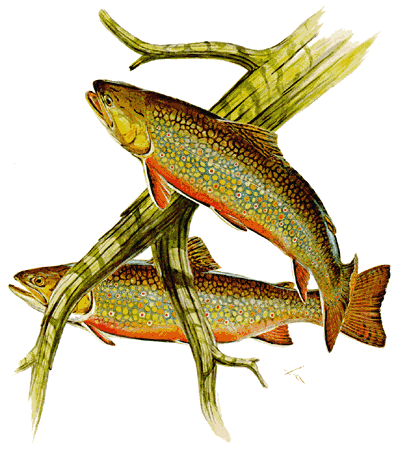 The classic way to prepare trout is au
bleu--poached in a
vinegar stock
that makes the skin turn a gorgeous
blue hue. It is the way it is
traditionally cooked in Europe, originating
in Switzerland and
popularized
in France. The French
do many things with trout: In Normandy it is pot
roasted with cider or cooked en papillote with
Calvados and
cream; in the Périgord region the fish is flambéed; in Burgundy it is cooked
in red wine. But truite au bleu
is
the most respected, so much so that French gastronome Jean
Giono
snipped, "With the exception of truite
au bleu nobody
knows how to cook trout. It is the most unfortunate
fish on earth. If an atomic
bomb destroyed the world tomorrow the human race would vanish
without
ever having known the taste of a
trout. Of course, I am no more talking
of the tank-bred trout than I
would give a recipe for cooking a dog or
cat."
Our
great American gastronome, James
Beard, who ate a good
deal of truite au bleu in his
time, would disagree,
however. When friends would bring
him just-caught trout from Oregon's Columbia River, he would
invariably
cook it with a coating of
cornmeal and bacon. The classic way to prepare trout is au
bleu--poached in a
vinegar stock
that makes the skin turn a gorgeous
blue hue. It is the way it is
traditionally cooked in Europe, originating
in Switzerland and
popularized
in France. The French
do many things with trout: In Normandy it is pot
roasted with cider or cooked en papillote with
Calvados and
cream; in the Périgord region the fish is flambéed; in Burgundy it is cooked
in red wine. But truite au bleu
is
the most respected, so much so that French gastronome Jean
Giono
snipped, "With the exception of truite
au bleu nobody
knows how to cook trout. It is the most unfortunate
fish on earth. If an atomic
bomb destroyed the world tomorrow the human race would vanish
without
ever having known the taste of a
trout. Of course, I am no more talking
of the tank-bred trout than I
would give a recipe for cooking a dog or
cat."
Our
great American gastronome, James
Beard, who ate a good
deal of truite au bleu in his
time, would disagree,
however. When friends would bring
him just-caught trout from Oregon's Columbia River, he would
invariably
cook it with a coating of
cornmeal and bacon.  "I have been castigated by a
gourmet-according-to-the-books
for even
mentioning the idea of bacon and trout together. But is it any
more
improbable to add the flavor of bacon
than to add lemon or vinegar, as in truite
au bleu? I hope someday
to have the chance to offer this
critic a perfectly sautéed mountain trout with bacon. I'm
certain he
will eat it with gusto, protesting the
while that it shouldn't be."
(To order "I have been castigated by a
gourmet-according-to-the-books
for even
mentioning the idea of bacon and trout together. But is it any
more
improbable to add the flavor of bacon
than to add lemon or vinegar, as in truite
au bleu? I hope someday
to have the chance to offer this
critic a perfectly sautéed mountain trout with bacon. I'm
certain he
will eat it with gusto, protesting the
while that it shouldn't be."
(To order James Beard's
New Fish Cookery , click on cover:)
Trout is far more versatile than
one might think, although
the simpler
the recipe, the better. But first and foremost,
the fresher the fish, the better.
If you don't have access to really fresh trout, you might as well
not
even bother cooking it at all. It can
taste fishy, its flesh can be mealy, and you might well wonder what
all
the fuss
is about. The
only sad part is this: By law, all fish served in a
restaurant
must come from a game farm. On
the one hand, this guarantees a consistent and healthy supply
of
fish; on the other it guarantees a
fairly mild flavor indistinguishable from one source to the next.
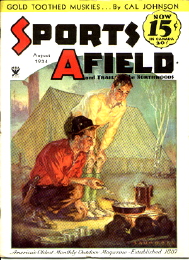 There is something special about a
well-caught, well
dressed,
well-cooked wild trout from a good river whose
flavor is finer, sweeter, and, well,
wilder than those fish that are "tank-bred." I say "good
river" because
not all trout dwell in pristine
waters or eat as well as they do in the Rockies. Trout from the Great Lakes
make have an oily taste picked up
from eating alewives, and there are far too many rivers in America
that
are muddy and polluted. Fresh from a
river, then, is not necessarily as good as fresh from a tank.
Incidentally,
you cannot only eat the skin
of wild trout, as with salmon, but it is absolutely delicious. There is something special about a
well-caught, well
dressed,
well-cooked wild trout from a good river whose
flavor is finer, sweeter, and, well,
wilder than those fish that are "tank-bred." I say "good
river" because
not all trout dwell in pristine
waters or eat as well as they do in the Rockies. Trout from the Great Lakes
make have an oily taste picked up
from eating alewives, and there are far too many rivers in America
that
are muddy and polluted. Fresh from a
river, then, is not necessarily as good as fresh from a tank.
Incidentally,
you cannot only eat the skin
of wild trout, as with salmon, but it is absolutely delicious.
Of trout cooked with bacon over coals in the
outdoors, Hemingway wrote, "The trout are crisp on the outside
and firm and pink inside and the bacon is well done--but not too
done. If there is anything better than that combination the
writer has yet to taste it in a lifetime devoted largely and studiously
to eating." It's always difficult to disagree with Hemingway.
NEW
YORK CORNER
by John
Mariani
ENNIO & MICHAEL RISTORANTE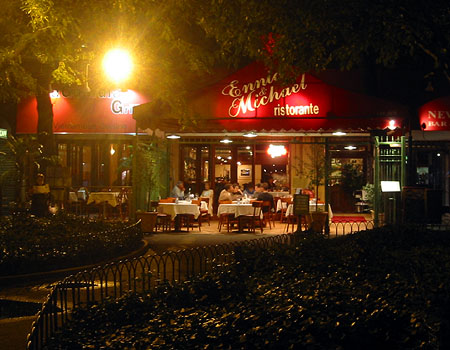 539 LaGuardia Place
212-677-8577
539 LaGuardia Place
212-677-8577
www.enniomichael.com
Once upon a time,
Greenwich Village was home to dozens of Italian-American
restaurants almost indistinguishable from one another in decor and
menu. They had names like Enrico & Paglieri, Nino & Nella, Gene's, Luigi's, and
Mario's, and they all served
dishes whose ingredients were purchased at low prices in order to keep
the menu prices cheap. Good olive oil? Real Parmigiano? Arborio
rice? Fuggeddabout it!
Then, in the
fall of 1978, two former waiters, Ennio Sammarone and Michael Savarese,
opened a
namesake place, Ennio &
Michael Ristorante, on Bleecker Street, where they started
serving updated versions of Italian-American classics along with dishes
from their native Abruzzo region. And they opened at a time when fine
Italian ingredients--balsamico, virgin olive oil, imported pastas, and
good wines--had begun to come to New York. Their success was
immediate, and people came to the Village eat well, not just to
catch
a plate of spaghetti or pizza slice before heading off to the Bitter
End or Café Wha.
Eighteen years ago Ennio &
Michael moved around the corner to larger quarters on LaGuardia Place,
with a splendid al fresco patio (above).
NYU was expanding, the Village was getting gentrified, and the two men
thrived without ever leaping on the uptown Italian bandwagon that sent
pasta dishes and veal chops soaring in price. But it was as much
the generosity of spirit that imbued E&M as the good food.
Ennio, usually up front, and Michael, usually in the dining room,
have never become complacent about their work or their regulars, and
newcomers are greeted with a warm welcome. There's one wall
covered with photos of celebrity guests (below) who have frequented E&M
over the years, some, like Bill Cosby, Danny Glover, and Peter Falk,
regulars. The late Chairman of the Board, Mr. Sinatra, was a fan
early on.
The
room is spacious, the tables nicely separated, with white
tablecloths. Up front is a curved wood-and-marble bar tended by
Ennio, and The winelist is nothing spectacular but serviceable and
reasonably priced. Prices for dinner have risen only gently in 28
years, with appetizers $9-$15.75, pastas $16-$22.75, main courses
$17-$26.75.
Every time I've dined here I always
order two dishes that are consistently among the best of their kind in
NYC: Stuffed artichokes, glistening with olive oil and well-seasoned
bread crumbs; and linguine with white clam sauce, abundant with small
sweet vongole clams, an
assertive dose of garlic, a fresh broth, and,
if you like, red pepper flakes. The owners bring in very good,
creamy mozzarella, served with Prosciutto, asparagus, and peppers, and
they also bake asparagus with a coating of Parmigiano that is
absolutely terrific. So, too, are the thinly sliced, crisply
fried zucchini.
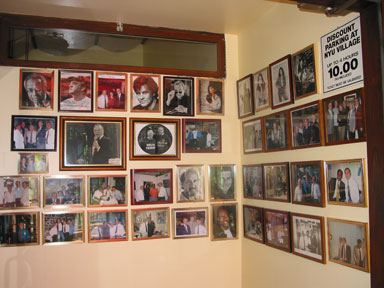 Very sensibly, the kitchen lists only six pasta dishes it
can make to order, with perhaps one or two specials each night.
Aside from the linguine with clam sauce, I love E&M's rigatoni alla Ennio, lavished with
a cheese-tomato sauce, peas, mushrooms, and sausage. For something
powerful, order the spaghetti alla
puttanesca, ripe with Gaeta olives, plenty of garlic, olive
oil, and basil. Very sensibly, the kitchen lists only six pasta dishes it
can make to order, with perhaps one or two specials each night.
Aside from the linguine with clam sauce, I love E&M's rigatoni alla Ennio, lavished with
a cheese-tomato sauce, peas, mushrooms, and sausage. For something
powerful, order the spaghetti alla
puttanesca, ripe with Gaeta olives, plenty of garlic, olive
oil, and basil.
For main courses I recommend pollo
all'arrabiata, a pungent dish of chicken morsels dashed with
garlic and
balsamic vinegar, and the eggplant alla
parmigiana is fragrant, rich,
and restorative. Scaloppini di
vitello alla Michael is tender veal with tomato and slices of
bufala mozzarella.
Desserts are fairly standard issue and
about as good as the better examples of Italian dolci in the
neighborhood.
Ennio & Michael are not pushing in
new directions, nor do they need to. Their commitment is to the
freshness of their food, made to order any way their patrons like
it. You come here for favorite dishes, sure that nothing has
changed about them, and for a chance to get a warm handshake, maybe a
kiss on both cheeks, from these two wonderful, ebullient Abruzzese
gentlemen.
NOTES
FROM THE WINE CELLAR
THE
TEN MYTHS OF
WINE
by John Mariani
 For
something that
is basically
just a
beverage—albeit one far more delicious than any other—an awful lot of
folderol
has grown up around the service and consuming of wine.
Indeed, wine drinking is fraught with
opportunities to show oneself either a naïf or a show-off, usually
both at the
same moment. I’ve found more people who
pretend to know a great deal about wine often go through ridiculous
rituals
that make about as much sense as waiting 30 minutes after eating before
going
swimming. Here are ten myths best laid
to rest ASAP:
1. Wine is a living
thing. On the contrary, once its
yeasts
have died off after fermentation, it is a dead and decaying thing,
which
nevertheless, like aged beef, can acquire wonderful flavor and balance.
But if
there’s anything still living in a wine bottle after fermentation ends,
it’s
definitely not supposed to be in there and mostly likely is going to
cause
problems.
2. All wine gets
better with age. Well, maybe one percent of all the white wines
in the
world
may (e.g., a white Burgundy
from a great vineyard and
vintage) and maybe
ten percent of all red wines. But most wines of both colors are these
days being
made to drink when they hit the store shelf, having already been aged
back in
the winery. Big reds from Bordeaux, California,
and Italy
gain with age, but most wines in
bottle gain
little if anything at all.
3. White wines
should always be well chilled and red wines served at room temperature.
A white wine chilled below 45° F will
lose flavors better tasted at
temperatures above
that. As for “room temperature,” the
phrase has no meaning if the room is 67° or 85° degrees.
"Cellar temperature" for reds is more like it: Best is
between
55 and 70. For
something that
is basically
just a
beverage—albeit one far more delicious than any other—an awful lot of
folderol
has grown up around the service and consuming of wine.
Indeed, wine drinking is fraught with
opportunities to show oneself either a naïf or a show-off, usually
both at the
same moment. I’ve found more people who
pretend to know a great deal about wine often go through ridiculous
rituals
that make about as much sense as waiting 30 minutes after eating before
going
swimming. Here are ten myths best laid
to rest ASAP:
1. Wine is a living
thing. On the contrary, once its
yeasts
have died off after fermentation, it is a dead and decaying thing,
which
nevertheless, like aged beef, can acquire wonderful flavor and balance.
But if
there’s anything still living in a wine bottle after fermentation ends,
it’s
definitely not supposed to be in there and mostly likely is going to
cause
problems.
2. All wine gets
better with age. Well, maybe one percent of all the white wines
in the
world
may (e.g., a white Burgundy
from a great vineyard and
vintage) and maybe
ten percent of all red wines. But most wines of both colors are these
days being
made to drink when they hit the store shelf, having already been aged
back in
the winery. Big reds from Bordeaux, California,
and Italy
gain with age, but most wines in
bottle gain
little if anything at all.
3. White wines
should always be well chilled and red wines served at room temperature.
A white wine chilled below 45° F will
lose flavors better tasted at
temperatures above
that. As for “room temperature,” the
phrase has no meaning if the room is 67° or 85° degrees.
"Cellar temperature" for reds is more like it: Best is
between
55 and 70.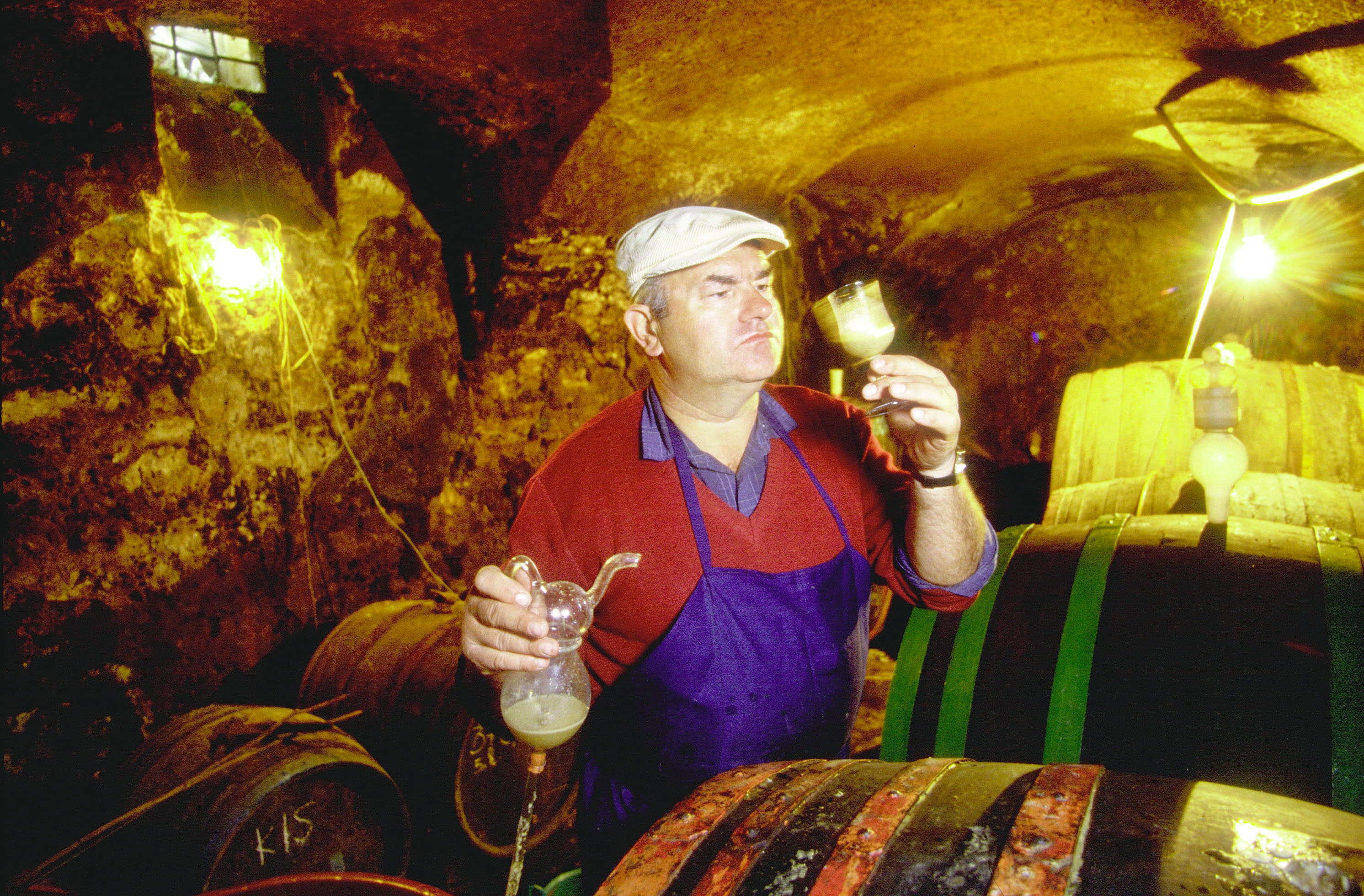 4. One should always
sniff the cork. Why? Ninety times out of a hundred it will
reveal
nothing,
unless the cork is so visibly rotted that you wouldn’t want to sniff
it. The
purpose of presenting the cork is wholly unnecessary these days—a
holdover from
days when an inferior wine was deliberately and unscrupulously
mis-labeled as a
better one—a scam exposed by looking at the cork, imprinted with the
original,
real provenance of the wine.
5. Red wines should
always be decanted to remove sediment. If a red wine has
sediment,
fine. If it
does not, there’s no necessity. Most red
wines do not throw off sediment anyway, and if one does, it will
usually take a
minimum
of at least five years to develop. Some enophiles contend that
decanting
brings
oxygen into the wine—which may help older wines of a kind that did have
sediment--but a few swirls of your glass will do the same thing. By the
same token, decanting can quicken aeration of both white and red wines,
and I must admit I've taken to decanting most of the time.
4. One should always
sniff the cork. Why? Ninety times out of a hundred it will
reveal
nothing,
unless the cork is so visibly rotted that you wouldn’t want to sniff
it. The
purpose of presenting the cork is wholly unnecessary these days—a
holdover from
days when an inferior wine was deliberately and unscrupulously
mis-labeled as a
better one—a scam exposed by looking at the cork, imprinted with the
original,
real provenance of the wine.
5. Red wines should
always be decanted to remove sediment. If a red wine has
sediment,
fine. If it
does not, there’s no necessity. Most red
wines do not throw off sediment anyway, and if one does, it will
usually take a
minimum
of at least five years to develop. Some enophiles contend that
decanting
brings
oxygen into the wine—which may help older wines of a kind that did have
sediment--but a few swirls of your glass will do the same thing. By the
same token, decanting can quicken aeration of both white and red wines,
and I must admit I've taken to decanting most of the time.
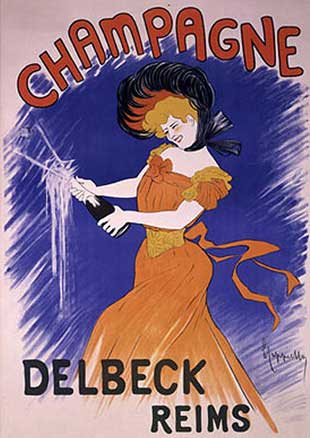 6. Vintage Champagnes must
all come from a single
vineyard. Nope. All vintage Champagnes
so labeled must indeed come from
a single,
outstanding vintage, but with only one or two rare exception out of
thousands,
they are always blends of various wines from various vineyards, as
determined
by a master blender to achieve harmony.
7. When tasting a
wine, you should suck in air and swirl the wine several times in your
mouth to
bring out the wine’s qualities or defects. Well, if you’re a
professional wine
taster—who may go through 50 wines at a time and spits the wines
out—this can
be helpful. But at a dinner table? Uh-uh. You’ll look ridiculous and
embarrass
your friends.
8. A wine should be
set at an angle in a wine cradle when served. The only reason
for those
silly—if often beautiful—wine cradles is to keep any possible sediment
in the
bottom of the bottle. But if there is any sediment, the wine should be
decanted
and rid of it. If there is no sediment (see Myth No. 5 above), why lay
the
bottle on its side? 6. Vintage Champagnes must
all come from a single
vineyard. Nope. All vintage Champagnes
so labeled must indeed come from
a single,
outstanding vintage, but with only one or two rare exception out of
thousands,
they are always blends of various wines from various vineyards, as
determined
by a master blender to achieve harmony.
7. When tasting a
wine, you should suck in air and swirl the wine several times in your
mouth to
bring out the wine’s qualities or defects. Well, if you’re a
professional wine
taster—who may go through 50 wines at a time and spits the wines
out—this can
be helpful. But at a dinner table? Uh-uh. You’ll look ridiculous and
embarrass
your friends.
8. A wine should be
set at an angle in a wine cradle when served. The only reason
for those
silly—if often beautiful—wine cradles is to keep any possible sediment
in the
bottom of the bottle. But if there is any sediment, the wine should be
decanted
and rid of it. If there is no sediment (see Myth No. 5 above), why lay
the
bottle on its side?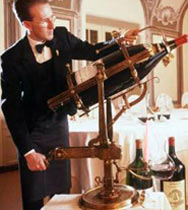 9. You should always
send back a wine you don’t like. No, you should only send back a
wine
that has
gone bad, either by being oxidized or corked. Just
because you don’t care for the taste of the wine is
no reason to
ask for it to be taken off your bill. The exception is when a wine
steward has
really pushed a wine on you that you’re unfamiliar with and you find
the wine
distasteful. Then, back it goes.
10. A screwtop
closure indicates an inferior wine. This used to be the case
until
corks were
discovered to cause malodorous corkiness in 5%-10% of all wines so
stoppered. Today,
however, many top wineries, including
many of the best in New Zealand,
at least one Premier Cru Chablis, and California's illustrious
Plumpjack are moving away from cork
towards screwtops
or the new glass stoppers developed in Germany. Stay tuned on this
score.
9. You should always
send back a wine you don’t like. No, you should only send back a
wine
that has
gone bad, either by being oxidized or corked. Just
because you don’t care for the taste of the wine is
no reason to
ask for it to be taken off your bill. The exception is when a wine
steward has
really pushed a wine on you that you’re unfamiliar with and you find
the wine
distasteful. Then, back it goes.
10. A screwtop
closure indicates an inferior wine. This used to be the case
until
corks were
discovered to cause malodorous corkiness in 5%-10% of all wines so
stoppered. Today,
however, many top wineries, including
many of the best in New Zealand,
at least one Premier Cru Chablis, and California's illustrious
Plumpjack are moving away from cork
towards screwtops
or the new glass stoppers developed in Germany. Stay tuned on this
score.
DRINK YOUR SOUP BEFORE IT CLOTS!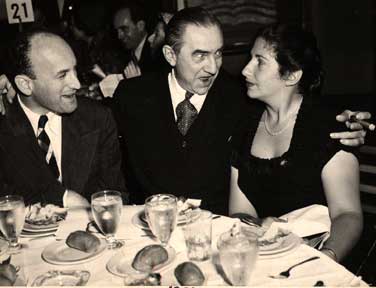
In Cincinnati a man
claiming to be a vampire plans to picket the
local White Castle because its new hamburger made with garlic has
"angered
the undead."

BLOCK
THAT METAPHOR!
"No, that
isn't the sun glinting off Mariah Carey's toe ring.
It's the sparkling Carrera marble powder that stands in for sand at the
Monte-Carlo Beach Hotel and Club."--Sandra Ballentine, "39 Ways to Have
a Sand Blast," NY Times (May
24, 2006).
QUICK
BYTES
*
From July 1-23, to commemorate
the Tour De France, Chef Jean Joho of Brasserie Jo in
Boston and Chicago will have daily menu specials to reflect the
culinary
influences of the regions the bikers drive through. The restaurant will
air the
race on a 42” TV. Also a raffle to win a TREK 1500 bike,
worth $1500.
*
On July 13 “Dancing
Under the Stars
with Midsummer Night Swing” at Lincoln Center
Festival 2006 will have a Celebrity Chef Food Tasting, incl. Julian
Medina,
Zocalo; Wylie Dufresne, WD-50; Marco Moreira, Tocqueville;
Sara
Moulton; Bill Telepan, Telepan; and Tom
Valenti, Ouest, in a benefit to support Lincoln
Center
for the Performing
Arts.
* On July 14 in Rye NY, La Panetiére will celebrate
"Bastille Day"
with a 5-course "Revolutionary Dinner" accompanied by an
accordionist, Nick Paone, who will entertain you with his "ginguette"
style music or any of your requests. $75 pp, wines $40 more.
Call
914-967-0654 or visit www.lapanetiere.com.
* From July
14-16 The
Glenlivet Single will host “The Glenlivet Gathering,” incl.
a
traditional Scottish dinner aboard a classic steam train, a private
tour of The
Glenlivet Distillery and tasting of stock with the Master Distiller Jim
Cryle, a
hike along the famous Smuggler’s Trail, a fitting for at to wear
at a traditional caleidh party) in The Glenlivet’s Malt Barn, Scottish
dances and Scottish cuisine. Each traveler
will receve a vintage of The Glenlivet
that will be exclusively bottled for guests attending The Gathering. Rooms
at the Aviemore Highland Resort. $3,500 pp. Visit www.theglenlivetgathering.com
* From
July13-16, Robert Mondavi Winery celebrates its 40th
anniversary
with TASTE3, a gathering
of 30 professionals in wine, food, and the arts, at Copia:
The American Center of Wine Food
& the Arts, incl. crystal
designer Georg Riedel; restaurateur Drew Nieporent; Archaeological
chemist Patrick McGovern; Leo
McCloskey, founder and president of Enologix; Marie
Wright, flavorist, International Flavors and
Fragrance/Visionaire TASTE project; UC
Berkeley-based historian Victor Geraci;
Margrit Mondavi, et al. In
addition to dinners at Napa Valley
wineries such as Harlan Estate, Quintessa, Stag's Leap Wine Cellars,
Rudd and
Grgich Hills Cellar, the events will feature 25 alumni of the
Great Chefs at Robert Mondavi Winery, incl. Alice
Waters, Thomas Keller, Bradley Ogden, Roy Yamaguchi, et al,
and 50 of America's top sommeliers at a dinner on July
15, paired with wines from Robert Mondavi
Winery's
wine library. $2,350
pp. Visit www.TASTE3.com or
call 707-967-3997.
*
From July 14-16, The Finger Lakes Wine
Festival®, supported by The Corning Museum of Glass will be
held, with 80
wineries from across the Finger Lakes region to set up at Watkins
Glen International, NY. The 2006
Festival kick-offs on Fri. with the 5th annual toga party, “Yancey’s
Fancy Cheese Launch of The Lakes”; Sat.
& Sun. will begin with the
Great Western Chardonnay Champagne Breakfast at the Glen Club, while
Saturday
evening is topped off with the Tasters’ Banquet. New
for 2006 is Finger
Lakes Tri-fecta’s
final bicycle race, hosted by
FingerLakesRacing.com, Sat. night. Call
866-461-7223,
or visit www.flwinefest.com.
*
On July 14, a Bastille
Day Celebration 10:00 p.m. will be
held at Carafe in Portland, whose French
community will presents a day-long celebration with the 2nd
annual Portland Waiters Race, a French marketplace, live music,
petanque
demonstrations, kid’s activities, and a pig roasted by Pascal Sauton of
Carafe.
Free admission. www.alliancepdx.org
or
call 503-223-8388.
* On July 14 Jean Francois
Meteigner of La Cachette in
L.A. will feature a 5-course “Parisian
Bistro
Night” for Bastille Day. $90;
with wine pairing $125. Call 310-470-4992 or visit www.lacachetterestaurant.com.
*
On July 15 The Culinary Vegetable
Institute and The Chef's Garden in Milan, OH, will hold its 2006 Food & Wine
Celebration, to
benefit the non-profit children’s program, Veggie U. It will feature feature musical
entertainment,
auctions wine from top vineyards all over the country and the culinary
creations of more than a dozen of the nation’s most renowned chefs.
Call 419-499-7500.
"THE
SWEET LIFE" CRUISE
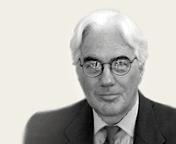 This fall, from Sept. 29-Oct. 6 John Mariani (left),
publisher of Mariani's Virtual
Gourmet and food & travel columnist for Esquire Magazine, will host
and lead a 7-day cruise called "The Sweet Life," aboard
Silverseas' Millennium Class Silver
Whisper,
with days visiting Barcelona, Tunis, Naples, Milazzo (Sicily), Rome,
Livorno, and Villefranche. There will be a welcoming cocktail
party,
gourmet dinners with wines, This fall, from Sept. 29-Oct. 6 John Mariani (left),
publisher of Mariani's Virtual
Gourmet and food & travel columnist for Esquire Magazine, will host
and lead a 7-day cruise called "The Sweet Life," aboard
Silverseas' Millennium Class Silver
Whisper,
with days visiting Barcelona, Tunis, Naples, Milazzo (Sicily), Rome,
Livorno, and Villefranche. There will be a welcoming cocktail
party,
gourmet dinners with wines, cooking demos by John and Galina Mariani
co-authors of The Italian-American
Cookbook), optional shore excursions will include a
tour of the Amalfi Coast,
dinner at the great Don Alfonso 1890 (2 Michelin stars), a private tour
of the Vatican, dinner at La Pergola (3 Michelin stars) in Rome, a
Night Cruise to Hotel de Paris and dinner at Louis XV (3 Michelin
stars)
in Monaco, and much more. Rates (a 20% savings) range from $4,411
to
$5,771. For complete information click. cooking demos by John and Galina Mariani
co-authors of The Italian-American
Cookbook), optional shore excursions will include a
tour of the Amalfi Coast,
dinner at the great Don Alfonso 1890 (2 Michelin stars), a private tour
of the Vatican, dinner at La Pergola (3 Michelin stars) in Rome, a
Night Cruise to Hotel de Paris and dinner at Louis XV (3 Michelin
stars)
in Monaco, and much more. Rates (a 20% savings) range from $4,411
to
$5,771. For complete information click.
~~~~~~~~~~~~~~~~~~~~~~~~~~~~~~~~~~~~~~~~~~~~~~~~~~~~~~~~~~~~~~~~~~~~~~~~~
MARIANI'S VIRTUAL GOURMET NEWSLETTER is published weekly. Editor/Publisher:
John Mariani. Contributing Writers: Robert Mariani, Naomi
Kooker, Kirsten Skogerson, Edward Brivio, Mort
Hochstein, Suzanne Wright. Contributing
Photographers: Galina Stepanoff-Dargery, Bobby Pirillo. Technical
Advisor: Gerry McLoughlin.
John Mariani is a columnist for Esquire, Wine Spectator, Bloomberg News and
Radio, and Diversion.
He is author of The Encyclopedia
of American Food & Drink (Lebhar-Friedman), The Dictionary
of Italian Food and Drink (Broadway), and, with his wife Galina, the
award-winning new Italian-American Cookbook (Harvard Common
Press).
Any of John Mariani's books below
may be ordered from amazon.com by clicking on the cover image.
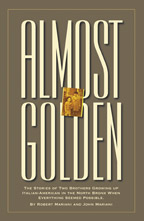 My
newest book, written with my brother Robert Mariani, is a memoir of our
years growing up in the North
Bronx. It's called Almost
Golden because it re-visits an idyllic place and time in our
lives when
so many wonderful things seemed possible. My
newest book, written with my brother Robert Mariani, is a memoir of our
years growing up in the North
Bronx. It's called Almost
Golden because it re-visits an idyllic place and time in our
lives when
so many wonderful things seemed possible.
For those of you who don't think
of
the Bronx as “idyllic,” this
book will be a revelation. It’s
about a place called the Country Club area, on the shores of Pelham Bay. A beautiful
neighborhood filled with great friends
and wonderful adventures that helped shape our lives.
It's about a culture, still vibrant, and a place that is still almost
the same as when we grew up there.
Robert and I think you'll enjoy this
very personal look at our Bronx childhood. It is not
yet available in bookstores, so to purchase
a copy, go to amazon.com
or click on Almost Golden.
--John
Mariani
|
copyright John Mariani 2006
|
|

 Esquire Magazine's first cover,
Autumn 1933
Esquire Magazine's first cover,
Autumn 1933
 The trout, whose species span two
whole
genera, Salvelinus
and Salmo, is
spread throughout the world's
The trout, whose species span two
whole
genera, Salvelinus
and Salmo, is
spread throughout the world's  As
with anything that seems lost in an idyllic past, trout fishing took on
mythic
overtones, and there grew
As
with anything that seems lost in an idyllic past, trout fishing took on
mythic
overtones, and there grew 
 The classic way to prepare trout is au
bleu--poached in a
vinegar stock
that makes the skin turn a
The classic way to prepare trout is au
bleu--poached in a
vinegar stock
that makes the skin turn a  "I have been castigated by a
"I have been castigated by a  There is something special about a
well-caught, well
dressed,
well-cooked wild trout from a good river
There is something special about a
well-caught, well
dressed,
well-cooked wild trout from a good river 
 Very sensibly, the kitchen lists only six pasta dishes it
can make to order, with perhaps one or two specials each night.
Aside from the linguine with clam sauce, I love E&M's rigatoni alla Ennio, lavished with
a cheese-tomato sauce, peas, mushrooms, and sausage. For something
powerful, order the spaghetti alla
puttanesca, ripe with Gaeta olives, plenty of garlic, olive
oil, and basil.
Very sensibly, the kitchen lists only six pasta dishes it
can make to order, with perhaps one or two specials each night.
Aside from the linguine with clam sauce, I love E&M's rigatoni alla Ennio, lavished with
a cheese-tomato sauce, peas, mushrooms, and sausage. For something
powerful, order the spaghetti alla
puttanesca, ripe with Gaeta olives, plenty of garlic, olive
oil, and basil. For
something that
is basically
just a
beverage—albeit one far more delicious than any other—an awful lot of
folderol
has grown up around the service and consuming of wine.
Indeed, wine drinking is fraught with
opportunities to show oneself either a naïf or a show-off, usually
both at the
same moment. I’ve found more people who
pretend to know a great deal about wine often go through ridiculous
rituals
that make about as much sense as waiting 30 minutes after eating before
going
swimming. Here are ten myths best laid
to rest ASAP:
For
something that
is basically
just a
beverage—albeit one far more delicious than any other—an awful lot of
folderol
has grown up around the service and consuming of wine.
Indeed, wine drinking is fraught with
opportunities to show oneself either a naïf or a show-off, usually
both at the
same moment. I’ve found more people who
pretend to know a great deal about wine often go through ridiculous
rituals
that make about as much sense as waiting 30 minutes after eating before
going
swimming. Here are ten myths best laid
to rest ASAP:
 6. Vintage
6. Vintage 


 cooking demos by John and Galina Mariani
co-authors of The Italian-American
Cookbook), optional shore excursions will include a
tour of the Amalfi Coast,
dinner at the great Don Alfonso 1890 (2 Michelin stars), a private tour
of the Vatican, dinner at La Pergola (3 Michelin stars) in Rome, a
Night Cruise to Hotel de Paris and dinner at Louis XV (3 Michelin
stars)
in Monaco, and much more. Rates (a 20% savings) range from $4,411
to
$5,771. For complete information click.
cooking demos by John and Galina Mariani
co-authors of The Italian-American
Cookbook), optional shore excursions will include a
tour of the Amalfi Coast,
dinner at the great Don Alfonso 1890 (2 Michelin stars), a private tour
of the Vatican, dinner at La Pergola (3 Michelin stars) in Rome, a
Night Cruise to Hotel de Paris and dinner at Louis XV (3 Michelin
stars)
in Monaco, and much more. Rates (a 20% savings) range from $4,411
to
$5,771. For complete information click. My
newest book, written with my brother Robert Mariani, is a memoir of our
years growing up in the
My
newest book, written with my brother Robert Mariani, is a memoir of our
years growing up in the 




